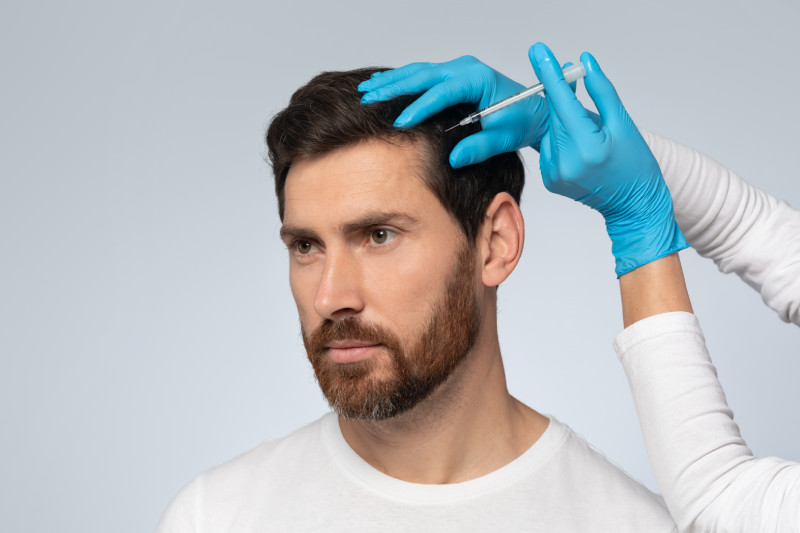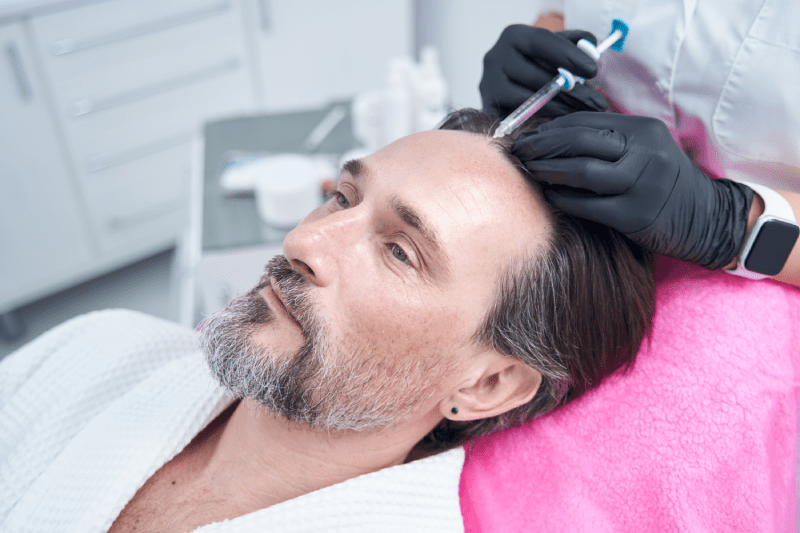What Is A Graft And What Is Its Importance For Hair Transplantation?
A graft is the name given to the piece of skin tissue taken from the donor area during hair transplantation operations, usually containing 1 to 4 hair follicles. Grafts, which are the fundamental unit of hair transplantation, are collected from areas like the nape of the neck and above the ears, which are genetically resistant to shedding. The success of an operation and the density to be achieved depend heavily on the number of healthy grafts and the quality of these grafts. Collecting sufficient and high-quality grafts is a prerequisite for achieving a natural and dense appearance in the recipient area. Therefore, the number of grafts is the most critical data point in the transplant planning process, directly influencing the final cosmetic outcome.
How Is Anesthesia Administered In Hair Transplant Operations?
In hair transplant operations, local anesthesia is generally administered. This type of anesthesia keeps the patient conscious while only numbing the nerve endings in the operation area, blocking the sensation of pain. Anesthesia administration can be made more comfortable using needle-free injection devices before the traditional injection. Thanks to local anesthesia, patients can read a book, watch television, or take breaks during the operation. Ensuring patient comfort throughout the procedure and completely eliminating pain is an important part of a successful hair transplant, contributing significantly to a positive patient experience.
Which Technique Provides Higher Hair Density?
The DHI (Direct Hair Implantation) technique is known to generally provide higher density compared to FUE, thanks to its ability to transplant between existing hairs and its use of finer implanter pens. Because channels are pre-opened in FUE, a limitation may be necessary to avoid damaging existing live hair follicles in the recipient area. Since DHI can implant directly between existing hairs without disturbing their angle, it offers the possibility of achieving a denser appearance, especially in thinning areas. However, the ultimate density achieved always depends on the richness of the patient’s donor area capacity.
What Is FUE Hair Transplantation And How Is It Applied?
FUE (Follicular Unit Extraction) is a hair transplant technique where hair follicles are individually extracted from the donor area using micro motors or manual tools. This method is the most preferred today because it is minimally invasive and leaves no wide linear scar. The collected grafts are then placed into channels opened in the recipient area. Local anesthesia is typically used during the application, so the patient does not feel any pain. FUE offers the potential for implanting a high number of grafts over large areas, allowing for a denser look in a single session. The success of this procedure hinges on preserving healthy grafts and opening channels at the correct angle during implantation.
What Is The Main Difference Of The DHI Hair Transplant Technique?
The main difference of the DHI (Direct Hair Implantation) technique is that the process of collecting and implanting grafts is performed almost simultaneously. Unlike the FUE technique, channels are not pre-opened; instead, the collected hair follicles are placed into a specialized tool called the Choi Implanter Pen. This pen simultaneously opens the channel and directly implants the root at the desired angle and depth. This “direct implantation” method minimizes the grafts’ time outside the body, potentially increasing the root survival rate. It also offers the ability to achieve denser implantation among existing hairs.
Why Is FUT Hair Transplantation Less Preferred Now?
The FUT (Follicular Unit Transplantation) technique is less preferred today because it requires a strip of skin to be surgically removed from the donor area. This strip is then separated into grafts under a microscope. This method leaves a larger and more noticeable scar compared to FUE and DHI. Tension and longer recovery times can occur in the donor area where the incision is made. With the advancement of technology, minimal invasive, less scarring, and more natural-looking techniques like FUE and DHI have come to the forefront, reducing FUT’s popularity significantly.
What Are The Hair Follicle Harvesting Methods?
Hair follicle harvesting methods fundamentally fall into two categories: FUE and FUT. In the FUT method, a strip of skin is surgically removed from the scalp, and the roots are separated from this strip. In the FUE method, roots are individually and sparsely taken from the donor area using specialized punches (typically 0.7 mm to 1.0 mm in diameter). Sub-variations of FUE, such as manual FUE or micro motor FUE, also exist. The DHI technique also uses a harvesting method similar to FUE, though the specific harvesting tools may vary. FUE’s advantage of leaving minimal scarring has made it the most widely preferred harvesting method today.
How Does The Choi Implanter Pen Used In The DHI Technique Work?
The Choi Implanter Pen used in the DHI technique is a specialized tool that combines three stages of the implantation process (channel opening, graft placement, and pushing the root at the correct angle) into a single motion. The fine tip of the pen (usually 0.6 mm – 1.0 mm in diameter) penetrates the skin directly without a pre-opened incision. The hair root is placed inside this pen and transferred to the skin using a piston mechanism. This mechanism increases the speed and precision of the implantation, while reducing the graft’s out-of-body time, thereby protecting root health.
How Does The Sapphire FUE Method Differ From Classic FUE?
The Sapphire FUE method differs from classic FUE in the way the implantation channels are opened. In classic FUE, channels are opened using metal slits, while in Sapphire FUE, specialized blades made of sapphire stone are used. Sapphire blades allow for opening channels that are finer, sharper, and smoother compared to metal slits. This minimizes tissue damage, accelerates the healing process, and enables grafts to be placed at more natural angles due to the V-shaped channels opened. Minimal trauma and faster healing are the key advantages of Sapphire FUE, appealing greatly to patients.
What Is The Main Procedural Difference Between FUE And DHI?
The main procedural difference between FUE and DHI is whether the channel opening and graft placement stages are separate or unified. In FUE, the surgeon first opens channels in the area using metal blades or sapphire tips, and then places the grafts one by one into these channels with tweezers. In DHI, the Choi Implanter Pen simultaneously creates the micro-incision and instantly transfers the hair root into that incision. While DHI reduces the grafts’ time outside the body, FUE allows the implantation stage to be completed more quickly.

Does The DHI Technique Cause Less Bleeding Or Trauma?
The DHI technique tends to cause less bleeding and tissue trauma compared to FUE. This is because the implanter pen tips used in DHI are smaller and perform the channel opening and placement process in a single, swift step. Since wide channels are not pre-opened, circulation in the area is less disturbed, and bleeding remains minimal. This contributes to less swelling (edema) and bruising after the operation, thereby accelerating the healing process and increasing patient comfort significantly.
Can The FUE Technique Be Applied To Larger Areas?
Yes, the FUE technique is generally more suitable for application to wider and larger baldness areas compared to DHI. The faster and bulk channel opening phase of FUE makes it easier for the surgeon to quickly distribute a high number of grafts over a wide surface area. The DHI technique is time-consuming due to the necessity of placing grafts individually, making its application logistically more challenging in very large baldness areas (e.g., over 5000 grafts). Therefore, FUE is a more efficient choice for covering extensive areas.
How Much Does The Implantation Time Differ Between DHI And FUE?
While the implantation time depends on the experience of the operating team and the number of grafts to be transplanted, the DHI technique generally takes longer than FUE. Since each graft must be individually loaded into the pen and meticulously placed in DHI, an operation involving 4000 grafts might take 8-10 hours with DHI, whereas it might take 6-8 hours with FUE. However, this longer duration is not a disadvantage in terms of graft quality and survival but rather an indication of more meticulous work and precise placement.
In Which Method Is Scabbing And Edema Seen Less?
Scabbing and edema are seen less in minimal invasive methods like DHI and Sapphire FUE compared to classic FUE. Sapphire FUE causes low tissue trauma because it opens fine, V-shaped channels. DHI is observed to have less swelling because it uses a direct implantation method that disturbs existing tissue minimally. Reduced scabbing and edema enhance the patient’s recovery comfort and allow for a quicker return to social life. Good post-operative care also supports this outcome.
Does Hair Implanted With FUE Look More Natural?
The natural look of implanted hair depends more on the surgeon’s artistic skill and experience than the technique itself. However, in FUE and Sapphire FUE, the surgeon’s ability to determine the correct angle (between 10-45 degrees) and direction when opening the channels is critical. DHI can yield more consistent results in some cases because it allows for direct adjustment of this angle with the pen. Generally, both modern FUE and DHI techniques, when performed by experienced hands, provide extremely natural and undetectable results in the hairline and overall density.
Which Techniques Can Be Used For Long Hair Transplantation?
Long hair transplantation, which is a method where the hair is harvested and implanted without shaving the donor area, can be performed with both FUE and DHI techniques. However, long hair transplantation is less preferred and is generally suitable for smaller areas because it prolongs the operation time and requires more sensitivity. The DHI technique, with its advantage of direct placement of grafts, allows for more comfortable work in long hair transplantation. Shaving the donor area remains the most practical and reliable solution for large areas.
Does The DHI Technique Lead To More Graft Wastage?
No, the DHI technique, on the contrary, aims to reduce graft wastage. The risk of graft wastage in FUE can stem from the grafts’ waiting time outside the body, while in DHI, the roots are damaged less because placement is done directly and quickly with the pen. However, errors made by inexperienced teams during the process of placing the root into the pen in DHI can damage the roots. Working with experienced surgeons and specialist teams is the most reliable way to minimize graft wastage in both FUE and DHI.
Which Technique Leaves The Least Scarring In The Donor Area?
The techniques that leave the least visible scarring in the donor area are FUE and DHI. These techniques create scattered micro holes by harvesting roots one by one; these holes heal within a few days, leaving behind tiny white dots that are almost unnoticeable. The FUT technique, on the other hand, leaves a visible linear scar in the nape area, which can be seen if the patient cuts their hair short. FUE and DHI are methods that allow the patient the freedom to wear their hair short.

With Which Technique Is The Naturalness Of The Hairline Better Adjusted?
The naturalness of the hairline largely depends on the surgeon’s artistic vision and their skill in correctly adjusting the direction of each graft. Both FUE and DHI offer sufficient technological infrastructure to ensure this natural appearance. However, DHI is sometimes preferred by surgeons for the front hairline to achieve more sensitive and natural transitions, as the implanter pen allows for millimeter-precise control of the angle and direction of each implanted root.
Which Technique Has A Higher Success Rate?
The success rate of the techniques depends not directly on the technology, but on the team’s experience, the quality of the grafts, and post-operative care. FUE, DHI, and Sapphire FUE are internationally recognized techniques with high success rates. However, DHI, which reduces the out-of-body waiting time, or Sapphire FUE, which opens finer incisions, can indirectly contribute to success by increasing graft survival. Generally, an expert team working with modern techniques aims to achieve a success rate above 90%.
Who Is An Ideal Candidate For The DHI Technique?
Ideal candidates for the DHI technique are those who are in the early stages of hair loss, those who want implantation in areas where their existing hair is thinning but not completely gone, or those aiming to increase density in small areas. Additionally, patients who do not want to shave their existing hair after the operation, and those seeking faster recovery and less trauma, are also suitable candidates for DHI. The meticulous nature of DHI makes it easier to implant densely between existing hair follicles without damaging them.
For Which Types Of Hair Loss Is The FUE Technique Suitable?
The FUE technique is highly suitable for types of hair loss that have wide baldness areas and require a high number of grafts (e.g., 4000-5000 grafts). This technique offers the possibility of covering large areas in a single session, thanks to its ability to open channels quickly and efficiently over a wide area. Patients with relatively strong donor areas, pronounced hairline recession, or large thinning in the crown area benefit greatly from the FUE technique.
Which Methods Can Be Attempted For Those With An Insufficient Donor Area?
For patients with an insufficient donor area, instead of standard FUE or DHI techniques, the goal is to better utilize a limited number of grafts. In this case, methods such as harvesting grafts from the beard or body hair (BHT – Body Hair Transplant) can be attempted. Although these grafts are generally not as durable as scalp follicles, they can be used to provide density in critical areas. Furthermore, accurate and careful planning of the donor area is paramount to ensure the most efficient use of available grafts.
Which Technique Is Recommended For Those With Curly Hair Type?
For those with curly hair types, the FUE technique can be more challenging because curly roots have a curved structure under the skin, increasing the risk of damage during harvesting. Therefore, special punch tips and a more careful harvesting process are required for curly hair. DHI may be preferred in some cases because it can adjust the root’s angle and placement direction more sensitively. The surgeon’s prior experience working with curly hair is a critical success factor in this type of transplantation.
What Should Be The Minimum Number Of Grafts For Hair Transplantation?
There is no absolute minimum number of grafts set for hair transplantation, as this varies depending on the person’s degree of baldness, the density of the donor area, and their expectations. However, for minimal hair loss cases where only the hairline needs strengthening, 1000 to 1500 grafts may be sufficient. For completely opened crown and frontal areas, it may be necessary to exceed 4000 grafts. The surgeon must conduct a careful evaluation to determine the minimum number of grafts that will provide the most natural result.
Why Are Medical Check-ups Required Before Hair Transplantation?
Medical check-ups before hair transplantation are vitally important to determine the patient’s general health suitability for the operation and to minimize potential risks. Blood tests show whether the patient has chronic diseases (diabetes, hepatitis, etc.), the risk of bleeding and clotting disorders, and their reaction to anesthesia. These check-ups ensure that the surgeon and the anesthesia team take precautions against any potential adverse events during and after the operation, maximizing patient safety.
Which Technique Should Be Preferred For A Second Hair Transplant?
DHI or FUE techniques are generally preferred for a second hair transplant; however, the status of the donor area is a critical factor. If FUE was used in the first operation and the donor area still has sufficient density, the same technique can be applied again. If an increase in density among existing hairs is desired, the DHI technique might be an ideal choice because the risk of damaging existing roots is lower. The number of remaining grafts and the healing status of the donor area before the surgery determine the surgeon’s decision.
When And How Should The First Wash Be Done After Hair Transplantation?
The first wash after hair transplantation should generally be done 48 to 72 hours (2nd or 3rd day) after the operation. This critical wash is important for both softening the scabs and reducing the risk of infection. The washing procedure is performed using a special lotion and shampoo, without rubbing or touching with nails the recipient area, applying only gentle water pouring and patting motions. This first wash is usually done under the supervision of the hospital or clinic to ensure the correct technique is learned.
When Does Post-Operative Shock Loss Begin And How Long Does It Last?
Post-operative shock loss generally begins 2 to 6 weeks after the implantation procedure. This is an expected and normal process where the transplanted hair follicles enter the resting (telogen) phase and shed the hair strands on them. This shedding usually lasts for a few weeks. Shock loss does not mean the hair roots are lost; the roots remain under the skin and start to grow again after 3-4 months. It is important for patients to endure this period patiently and without losing morale, for the final result.
Is The Return-To-Social-Life Period The Same After DHI And FUE?
The return-to-social-life period after DHI and FUE is very similar, but DHI may generally be slightly faster due to less trauma. In both techniques, noticeable scabbing and redness largely disappear within 7 to 10 days. Since DHI involves less edema and fewer micro-incisions, the first few days are more comfortable. Full normalization of appearance and the ability to cut the hair short can take up to 1 month in both techniques.
How Is Edema And Swelling After Hair Transplantation Managed?
Edema and swelling after hair transplantation can be seen, especially in the forehead and around the eyes, and this condition generally lasts for the first 3-5 days. For edema management, it is important for the patient to sleep in an upright position (with a high pillow) for the first 48 hours, regularly take anti-edema medications recommended by the doctor, and apply cold compresses to the forehead area. Avoiding excessive salt consumption and drinking plenty of water also helps the swelling subside quickly. These measures accelerate the healing process and enhance patient comfort.

How Long Does It Take For Implanted Hair To Fully Grow Out?
The process for implanted hair to fully grow out and the final result to be seen generally takes 12 to 18 months. New hair starts to grow after the shock loss in the first 3-4 months. A significant portion of the hair will have grown out by the 6th month, and a noticeable change will be observed. However, for the hair strands to thicken, mature, and take their natural direction—meaning the hair to completely ‘settle’—continues up to 1 year. This long process requires patience and regular follow-up.
Why Should Smoking And Alcohol Be Prohibited During The Healing Process?
The prohibition of smoking and alcohol during the healing process is critical. Smoking constricts blood vessels and reduces blood flow, which decreases the amount of oxygen and nutrients reaching the transplanted hair follicles, negatively affecting the graft survival rate. Alcohol thins the blood, increasing the risk of bleeding and bruising. Because these substances slow down the healing process and increase the risk of infection, they should be strictly avoided for at least 10 days before and after the operation.
Is It Possible For Scars In The Donor Area To Disappear Completely?
It is possible for scars in the donor area to completely disappear (become invisible) with FUE and DHI techniques. The small holes created by the micro-diameter tools used in these techniques close within a few days, and even when the hair grows out by a few millimeters, they are very difficult to notice. The minimal scarring in the donor area preserves the patient’s freedom to cut their hair short. However, the FUT technique leaves a permanent linear scar, so complete disappearance is not possible.
What Are The Factors Determining Hair Transplant Prices In Turkey?
The most important factors determining hair transplant prices in Turkey are the technique used (DHI, Sapphire FUE, Classic FUE), the number of grafts to be transplanted, the accreditation level of the hospital where the surgery will be performed, and the scope of the comprehensive package offered. The surgeon’s experience, whether the operation is performed by a single surgeon or a team, and the quality of the accommodation, transfer, and long-term follow-up services included in the package also play a major role in pricing.
Why Are Hair Transplant Prices In Turkey More Affordable Than In Europe?
The main reason why hair transplant prices in Turkey are more affordable compared to European countries is the low general operating and labor costs. Clinics in Turkey have lower operational expenses with expert teams who have received the same quality and international standard training. Furthermore, the value of foreign currencies like the Pound and Euro against the Turkish Lira offers international patients the advantage of receiving the same high-level service at much more economical prices. This allows for saving without compromising on quality.
Which Is The Most Expensive And Most Economical Hair Transplant Technique?
Generally, the DHI technique is considered the most expensive technique because it requires more meticulousness, time, and a special Implanter Pen. The Classic FUE technique is generally the most economical option because the channel opening and graft placement phases can be done faster and more efficiently. However, pricing depends not only on the technique choice but also on the team’s experience and the number of grafts to be transplanted. FUT can be moderately high-cost due to its surgical complexity.
What Logistical Services Should Hair Transplant Packages Include?
Comprehensive hair transplant packages should generally meet not only the patient’s medical but also logistical needs. These services should include VIP airport transfers (round trip), hotel accommodation before and after the operation (usually 2-3 nights), professional interpreter service, and the necessary medication, shampoo, and lotions to be used post-operation. This all-inclusive approach ensures the patient’s experience in Turkey is comfortable and stress-free.
How Significant Is The Cost Difference Between FUE And DHI Techniques?
The cost difference between FUE and DHI techniques is not very significant in terms of the quality of the operation’s result; what is important is which technique the surgeon is more specialized in. DHI can generally be 15-30% higher in price, but this difference should be determined by the patient’s expectation (implantation between existing hairs) or the surgeon’s preference. The patient should focus on researching which technique is most suitable for their type of hair loss and donor area status, rather than just the cost difference.
Why Should Cure Holiday Be Preferred For Hair Transplantation In Turkey?
Cure Holiday should be preferred for hair transplantation in Turkey because Cure Holiday collaborates with internationally accredited hospitals and works with highly experienced teams with high case volumes in the field. They enable you to receive service at European standards at much more affordable prices without compromising medical quality. Furthermore, they offer fully comprehensive, transparent packages (accommodation, transfer, interpreting) to entirely eliminate the logistical worries of patients coming from abroad. You can contact Cure Holiday to create a personalized hair transplant plan and confidently start this transformation journey.



